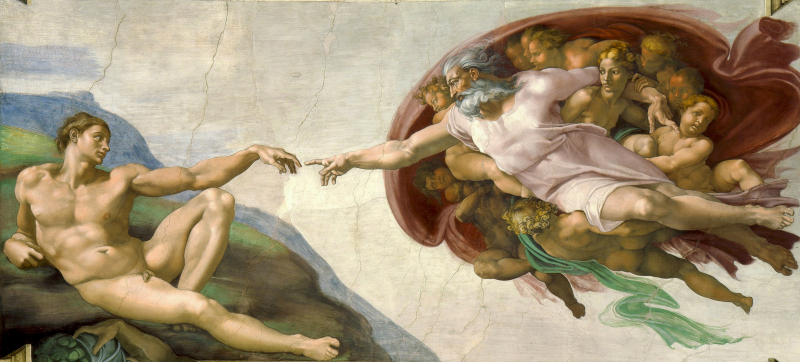The Creation of Adam
Michelangelo's "The Creation of Adam" is a complex narrative that melds divine interaction with profound human intellect. It is much like his other works that explore deep religious and existential themes. Painted as part of the Sistine Chapel's ceiling between 1508 and 1512, this fresco captures the moment when life is imparted to the first man, Adam, by God.
At the core of the painting is the nearly touching hands of God and Adam. This gap, although minimal, is profoundly significant. It represents the moment just before the spark of life is given – a suspenseful pause full of potential. This iconic gesture has been embedded deeply in the cultural consciousness. It symbolizes creation, inspiration, and the divine spark within humanity.
Michelangelo, known for his anatomical precision, is believed to have embedded a representation of the human brain within the shapes surrounding God. This might suggest that God is not just imparting life but also the gift of human intellect. This aligns with Renaissance humanism. Where there was a deep belief in the potential and dignity of the individual and a focus on the capability of the human mind.
In "The Creation of Adam," the figures are reflections of human emotion and condition. Adam's posture and expression are passive, almost as if he's waiting for life and purpose. This contrasts with God's dynamic movement, surrounded by figures, reaching out to Adam. This could symbolize the human condition of waiting for divine inspiration or a moment of awakening.
The female figure under God's arm is thought to be Eve, waiting to be created, or perhaps the Virgin Mary. They symbolize the future of humanity. The presence of these figures next to God as he creates Adam suggests the interconnectedness of creation, life, and the divine plan. The painting also features children, possibly representing future generations. It emphasizes the ongoing nature of creation and life.
"The Creation of Adam" is a fusion of art, theology, and philosophy. Michelangelo doesn't just paint a scene; he invites contemplation of larger questions. What is the nature of humanity? What is our relationship with the divine? How do intellect and creativity define us? These questions remain as relevant today as they were during the Renaissance.
Key Takeaways:
- Title: The Creation of Adam
- Artist: Michelangelo Buonarroti
- Year: 1508-1512
- Medium: Fresco
- Size: 280 cm × 570 cm (9 ft 2 in × 18 ft 8 in)
- Location: Sistine Chapel, Vatican City













